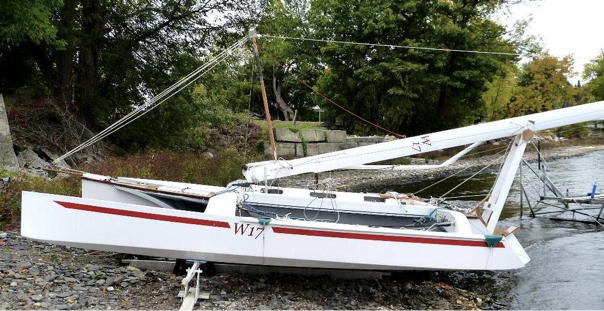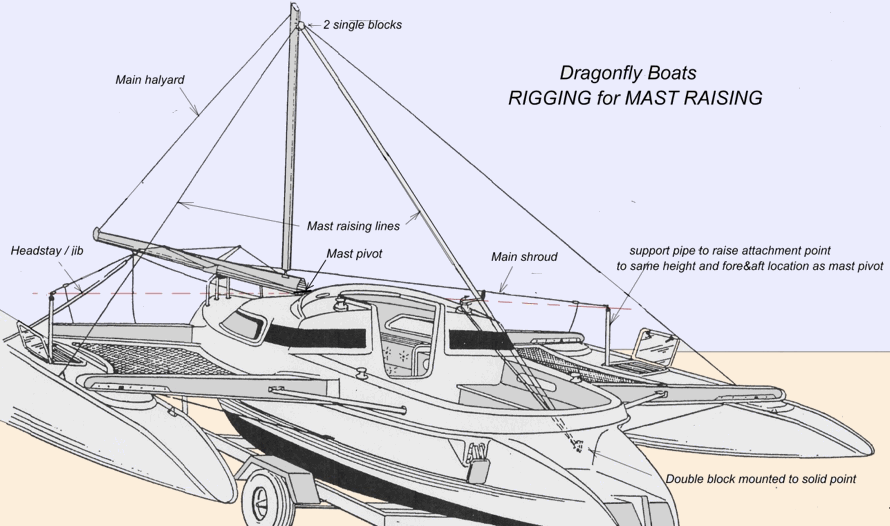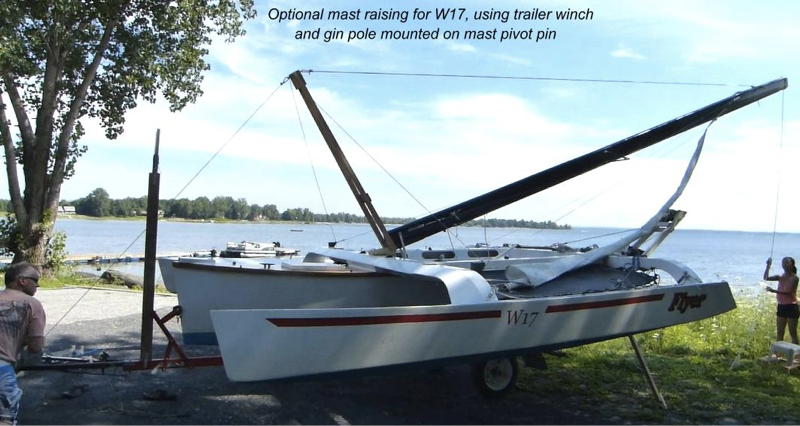


Basics of Mast Raising
IF you have the luxury of a mast crane, then all it needs is a sturdy rope strop around the mast and under the spreader - typically just above the center of gravity of the mast – and you’re all set. Of course, you need to pre-think the attachment so that you can pull it down from the mast after it’s in place, but that’s not so complicated … even a light line snapped on, can work as long as you’re not wrapped around 2 sets of diamonds! Otherwise you may be climbing the mast before you even go sailing ;-)
But most of us on relatively small boats that are trailed to the launch site, need to get equipped to raise and lower your mast independent of cranes … and often while alone. So here are the basics.
The mast needs a pivot bolt at the mast base, that’s located athwartships, so that the mast cannot rotate on it’s axis, but can pivot down, either fore or aft. Which way you go will depend on the deck arrangement and pivot height. As the distance from mast step to the stern is typically longer than to the bow, lowering aft makes more sense for mast support when down .. but with some boats, the cabin top or hatchway is higher than the pivot and then it’s easier to lower the mast forward, even if it means making a temporary support for the mast either on the ground or on your tow vehicle. Some boats have a raised tabernacle for the pivot in order to clear the cabin, so that’s another solution for lowering aft.
You’ll need a crutch to support the mast when it’s down .. and if you can incorporate a roller on this crutch it’s good to do so, as the mast will almost certainly need to be rolled or slid back over the boat once down, in order to limit the overall length for trailing.
For raising (or lowering) you will need these basics:
-
A gin pole to give you lifting leverage. This needs to be able to take the compression while lifting (figure on at least double the mast weight) and be not less than 1/4 the mast length. The closer this is mounted to the mast pivot the more effective it is, but a boom mounted on a sturdy gooseneck that’s not too high up the mast still works.

Side guys to keep both the gin pole AND the mast itself, close to the boat centerline. If fixed in length, these lines need to be attached to a pivot as far outboard as practical, and with an eye at the same height as the pivot bolt for the mast foot. Such an attachment can be arranged either with a bracket or raised stanchion that’s temporarily bolted to the boat (or ama in the case of a trimaran), or can also be rigged to an type of bridle at the boat side. Such a bridle needs a strong ring to which the side guy is attached and then have lines forward and aft that are adjustable so that when under tension, the ring is brought to be in line both horizontally and fore & aft with the mast pivot bolt. Setting this up is tricky the first time, but after the attachment points are established and the ropes are marked, one can easily set it up to those marks in future and know that the ring will be well located. Periodically check for line stretch though.
Guys for the mast itself, can sometimes be the actual shrouds, as long as they are not initially too long and that they use adjustable tackles to tension them. Sometimes a mast is equipped with lower shrouds that can be used or even trapeze lines, as IF the mast is kept close to the centerline, the side load will not be high.
Guys for the Gin Pole, can either be dedicated lines that are fixed in length and snapped to a location in line with the mast pivot .. OR they can be a part of the tackle that is used for hauling up the mast itself. Such a system is used by the Dragonfly Boats – rigged with two lifting lines, one port and one starboard. EACH of these lines are fixed to the ama near the aft beam and run up to a block at the end of the gin pole (or boom) and then back down to a block on the centerline at the stern and then forward to a winch. So there will be two blocks at each location ... at the boom/ginpole end, and at the rear of the cockpit. The two lines go around the winch together.

Typically the main halyard is used while raising the mast …, running from the upper end of the gin pole (or boom), through the mast head sheave and down the mast to a sturdy cleat near the mast base, well tied off. From the underside of the gin pole (or boom), the mainsheet is often snapped on to haul the gin pole back to raise the mast .. or if the mast was laying aft and is being raised forward while on a trailer, then the boat winch line can be used, snapped to the underside of the gin pole end (or boom), so that the trailer winch itself can be used to do the raising work.
If the boat is not on a trailer, a multi-part tackle (4,5 or 6 parts may be required) can be attached to the end of a bowsprit to raise the mast. Both these system have successfully been used to raise the wing mast on a W17 trimaran, though using the trailer winch with a dedicated gin pole that pivots on the same pin as the mast, has proven to be the faster method.
-
Just a word about the crutch for the mast. The preference for a roller has already been mentioned. This crutch needs to be as high as practical as then the starting load to lift the mast is reduced. At the same time the upper-mast-tip still needs to be within local height clearances for trailing .. so generally preferable to stay around 10ft (3m) or so. In the case of the W17, the crutch is dropped into the stern well and slopes aft at about 35-40 deg from the vertical. (The crutch in the photo below, shows it much too low, after the lines slipped during a long trip). The mast should lower to the crutch with the spreaders forward of it, so that they do not make things difficult to roll the mast forward to the trailing position after the mast is lowered. See also this article on Handling the W17 ashore.
If lowering the mast forward, then a crutch on your towing vehicle can help give good height, or otherwise you may need a temporary stand or tripod on the ground, that has a central support that you can raise by hand and then clamp or pin in place … as the higher this is, the less load you will have on the lifting lines. (I even have an old paddle with a notch in its blade that fits the mast section. A tall crew member can then give the mast a push up at the beginning of the lift to reduce the starting lift load).

In conclusion, there are MANY ways to raise a mast, but unless your whole rig is non-standard, they generally are all variants of what is described above. Check everything twice to see all ropes and parts are well attached and not entangled, and you’ll be fine.
Mike
"New articles, comments and references will be added periodically as new questions are answered and other info comes in relative to this subject, so you're invited to revisit and participate." —webmaster
"See the Copyright Information & Legal Disclaimer page for copyright info and use of ANY part of this text or article"